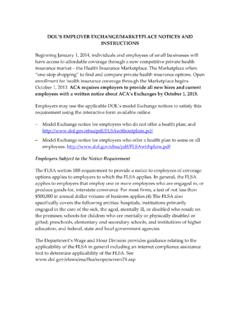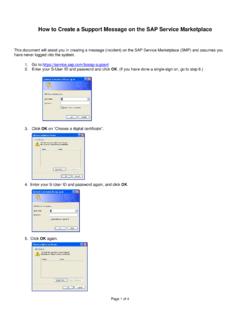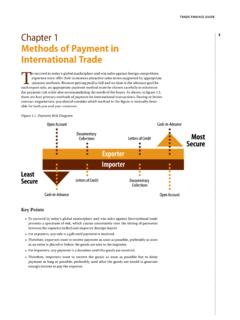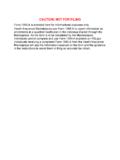Transcription of How the Government as a Payer Shapes the Health Care ...
1 2014 How the Government as a Payer Shapes the Health care marketplace By Tevi D. Troy 2014 2014 American Health Policy Institute (AHPI) is a non-partisan 501(c)(3) think tank, established to examine the impact of Health policy on large employers, and to explore and propose policies that will help bolster the ability of large employers to provide quality, affordable Health care to employees and their dependents.
2 The Affordable care Act has catalyzed a national debate about the future of Health care in the United States, and the Institute serves to provide thought leadership grounded in the practical experience of America s largest employers. To learn more, visit ghgvghgghghhg Contents Executive 1 Shaping Business Models .. 2 Insurance Premiums .. 6 Availability of Innovative Products .. 7 Quality Measures .. 8 Conclusion .. 9 Endnotes .. 10 2015 American Health Policy Institute 1 Executive Summary The federal Government is the largest single Payer of Health care in the United States1, accounting for more than a quarter of all spending on Health care .
3 Having a single entity provide so much of the revenue for an industry gives that entity outsize influence in that industry. Consequently, as the nation s largest Payer , the federal Government is able to significantly shape and move the Health care market. Whether it is the Centers for Medicare and Medicaid Services (CMS) determining which treatments and technologies are worth covering and how much they are willing to reimburse for them; the Agency for Healthcare Research and Quality (AHRQ) mandating quality and safety standards.
4 Or the new Affordable care Act (ACA) exchanges setting the standard for benefit packages throughout the Health insurance market, it is clear that Government agencies and their mandates play a powerful role in guiding the provision of Health benefits and the overall construct of the market. In recent years, a number of Health policy trends have highlighted the significant role the federal Government plays as a Payer of Health care : The federal Government s role as both regulator and Payer of the insurance industry has resulted in several key insurance mergers over the past year, which has reshaped the country s Health insurance market; The Government encourages businesses to serve as test cases for Government preferred payment models such as bundled payments and ACOs.
5 The federal Government s role as the dominant Health care Payer has a variety of powerful effects on reimbursement to providers most notably through Medicare, but also in terms of the potential cost shifting that occurs and is borne by private payers; The federal Government s ACA exchange plans serve as a benchmark for private plans, which has a ripple effect in setting prices for other insurance plans, as well as for employers determining levels of coverage; The Federal Employee Health Benefit Plan (FEHBP), influences not only the shape of Health plans provided, but also who is providing them; The Government s dominant Payer role Shapes the face of innovation adoption.
6 For example, when it comes to telehealth, Medicare reimbursement models are determining how new technology will be integrated in the practice of medicine; and The Government s Agency for Healthcare Research and Quality (AHRQ) sets national Health care quality standards, which play a role in payment models. As this paper shows, these various ways in which the Government in its role as Payer attempts to influence Health care beg the question of what other players in the space will do in response and what this could possibly mean for the nation s Health care system in the future.
7 These other players in the marketplace will likely reconsider their respective roles and strategies to see if they, too, have the ability to consolidate and use collective influence. Health care providers, insurance carriers, and pharmacy benefit managers are already doing so, and other entities, such as employers, may follow as well. In the process, these consolidating entities may change the face of Health care as we know it. The key question is whether the changes undertaken by these players will, together with Government , enhance or detract from the widely proclaimed goal of better quality of Health care at a more affordable cost.
8 2015 American Health Policy Institute 2 Shaping Business Models One of the major ways in which the federal Government s payment role Shapes our Health care industry is in its impact on large insurers. This influence takes place in a number of ways that go beyond the federal Government s role as a regulator. It is the Government s role as a revenue source that makes it so important to the insurance industry. According to an estimate done by Barclay s Equity Research Group, while employers account for 43 percent of the major carrier s covered lives and Government sponsored programs account for a roughly equivalent 39 percent of the carriers covered lives, the Government accounts for 64 percent of the major carrier s revenue compared to just 6 percent coming from employers (See chart below).
9 2 Sources of Insurance Carrier Revenue and Covered Lives The disproportionate amount of revenue coming from Government (10 times more than employers) means that the carriers are cognizant that the Government is their main customer when designing business models. Moreover, carrier revenue growth has been largely driven by Government programs over the past three years. One of the reasons for the recent merger mania among carriers is an effort to accommodate this large and growing customer. According to an analysis by News and World Report, the mergers were initially triggered by the onset of Medicare managed care plans decades ago, but picked up steam recently with the ACA and its effort to move increasing numbers of Americans into Government -sponsored coverage, be it through the ACA exchanges or Compounding this shift is the movement of the growing number of retirees entering into Medicare Advantage programs.
10 These shifts are part of a larger movement away from private sector and towards public sector coverage. Commercial Risk, 30%Commercial ASO, 6% Government Programs, 64%Estimated Carrier RevenueCommercial Risk, 18%Commercial ASO, 43% Government Programs, 39%Carrier MembershipNotes: Membership information provided to PwC by Barclay s equity research group. As of Q1 2015. Includes members from Aetna, Anthem, Cigna, Centene, Health Net, Humana, Molina, United Healthcare and Wellcare; Revenue information is estimated 2015 American Health Policy Institute 3 Insurance industry commentator Wendell Potter wrote that we are moving towards a system of more and more people enrolled in public programs, which are going to grow as baby boomers age and the Medicaid program grows.








